(Note: There are photos at the end of this post.)
What would an RV rally be without rain? Rain was forecast for overnight into today, and rain it did. We had heavy downpours starting at midnight and lasting until 2 AM, with lighter rain through the rest of the night and into the early morning. Coffee and donuts are traditional breakfast fare provided as part of RV rally fees. We walked over around 8:15 and got some coffee. (I had a donut even though it violates our WFPB way of eating since it contains eggs, but they are my one, true weakness.)
We headed towards the seminar building for a 9 AM seminar on the Rand-McNally GPS unit. Along the way we stopped to chat with Lloyd De Gerald, an independant factory-trained Aqua-Hot technician. We attended Lloyd’s Aqua-Hot presentation at the FMCA rally in Gillette this past June. We have not had our Aqua-Hot serviced since the rebuilt unit was installed in 2009/10 and thought we would like to have him do our annual maintenance if we ever ran across him again. And here he was! So we signed up for an 11 AM service appointment today.
We have one of the first Rand-McNally RVND7710 GPS units built. We pre-ordered it at the FMCA national rally in Madison, Wisconsin in August 2011 and received it in October 2011. It has been an excellent unit, but it has a lot features that we have not taken time to learn to use. I keep hoping I will pick up some useful tips at seminars but they are not necessarily the place to get such specific training. However, Techno RV (Phil and Tracey May) has produced an excellent set of tutorial videos which they make available via an e-mail newsletter even if you did not buy the unit from them. We did learn that the newest model, the 7720, has built-in WiFi which allows it to connect to a cell phone hotspot while traveling and thus acquire some additional real-time information; a nice feature. The price has also come down (of course) and now includes lifetime map updates (naturally).
After the seminar we took a quick stroll through the vendor area. We stopped at the Blue Ox booth and signed up to have our Avanti II tow bar serviced as we have not had this done since we acquired it as part of the purchase of the Honda Element in the Spring of 2010. Directly across the aisle was the Harvest Hosts booth so we stopped to chat with the couple staffing it as Don and Kim Greene were not able to make it to this rally in person. We also chatted with the folks in the adjacent Always-Bright-And-Shiny booth. We purchased our built-in vacuum cleaner from them at a previous GLASS rally and also some of their aluminum wheel cleaning and polishing products. They had a really neat “2-burner” black glass top induction cook surface for sale. It is designed for a recessed installation, but could sit on a counter although it would be rather large. It was a 120 VAC device, although you could not run both heaters at full power at the same time.
We started to run short of time so we returned to our coach to make sure we were they when Lloyd showed up. The weather forecast was for continued heavy thunderstorms and the radar confirmed significant weather headed our way, so we decided to put our Zip Dee Awnings up. Lloyd arrived on time just as it started to rain lightly. I fired up the Aqua-Hot so he could see and hear it start and then shut it down so could listen to that end of the cycle. By then it was raining harder and we decided that he would come back when the weather was a bit more agreeable.
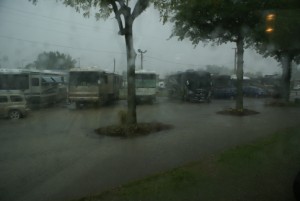
The view out our passenger side living room window.
We had an early lunch and Linda put together plates of three different leftovers, all of which were excellent. Around 11:45 AM heavy thunderstorms moved into the fairgrounds with frequent lightening, thunder, and 2 inch per hour rainfall rates. This part of Indiana had not had rain in a while and needed it, but this was too much of a good thing as heavy rains tend to run off and swell creeks, streams, and rivers. A flash flood warning was issued for Elkhart County.
We had planned to attend a 1 PM presentation on the Silverleaf Engine Monitor Systems. At 12:30 PM we got another band of really heavy rain and standing water started to appear around most of the coaches parked in our part of the fairgrounds. I don’t think the fairgrounds were in any real danger from significant amounts of rising water, but the drainage where we are parked turned out to be less than ideal and a lake started to form in our part of the fairgrounds surrounding motorhomes and cars. By 12:45 PM we decided to stay put and by 1:30 PM the water had reached the bottom of the rims on our Honda Element. Linda decided to move the car to higher/drier ground. Given all of the electrical service lying on the ground, I didn’t think going out into ankle deep water was a very good idea, but she survived the experience. (So did I as I stayed inside and worked at my computer.)
We have a Silverleaf VMS Interface that works with the diagnostic connector for the Engine Control Computer (EEC) in our bus and plugs into a laptop computer running Silverleaf’s VMSpc software (Vehicle Monitoring System personal computer). I have never installed it because I haven’t figured out a good way to mount the laptop computer where I can see it but not have it in the way. I decided some time ago that the best solution would be to mount the computer and interface box remotely and install a secondary flat-panel monitor, which would give me more flexibility with respect to the mounting of both the computer and the monitor. I never finalized my decisions regarding mounting hardware and the flat-panel monitor, so this remains an unfinished/future project for now.
There wasn’t any entertainment planned for this evening so that chapters could have a time to meet that did not conflict with other activities, except perhaps for other chapter meetings. Our Great Lakes Converted Coaches chapter social/dinner and business meeting was scheduled for 6 PM in the Elkhart Noon Optimists Club pavilion located at 603 Locust Street (one of the fairground interior roads). Butch ordered the pizzas yesterday from the local Pizza Hut and arranged for them to be delivered to Gate 5 at 5:30 PM. Butch checked in with Linda around 3 PM to see what the short-term weather forecast looked like, and they decided that the pizza party should go on as planned. I suspect that Butch was at the point-of-no-return with Pizza Hut and had to tell them yes or no for this evening. (Butch was kind enough to order two thin crust veggie, no cheese pizzas so Linda and I would have something to eat.)
The other seminar I planned to attend today was at 4 PM on designing and publishing websites. Unfortunately heavy rain continued off and on until around then, and I decided not to go. By 4:30 the sky had started to clear from the north and west, but we had several inches of standing water surrounding our coach and throughout the area of the fairgrounds where we are parked. I was curious to find out how long it would take for this water to disappear as it did not appear to have anywhere to go. The ground here was packed extremely hard when we arrived, to the point where we could not get sign wires pushed into it. While this area needed rain, we do not as a rule welcome inches of standing water substantially softening the ground under our tires.
With the improved weather Lloyd returned around 5:15 PM as Butch and I were getting ready to leave to meet the pizza delivery person. I took a few extra minutes to talk to him. He had access to everything he needed in the bay so I left him to his work. We will catch up with him tomorrow and pay him. Not all vendors are this trusting, but in general we have found vendors at RV rallies willing to lend us a part, like an LED light bulb, to see if it will fit our coach on nothing more than the promise that we will bring it back or return and pay for it. Not all RVers are honest, of course, but we always feel very safe when we are at RV rallies.
I went with Butch to help him with the pizzas, which arrived right on time. We drove them over to the pavilion and unloaded them along with soda pop, ice, and table settings. The GLCC gathering was well attended. Just as we were getting started FMCA national president Charlie Adcock and his wife Gloria stopped by with senior national vice-president Jon Walker (a member of our GLCC chapter). Jane Roush, GLAMA President also stopped by. They didn’t stay long as they had to visit all of the chapter meetings, but everyone appreciated them coming. Judy Czarsty, FMCA past national president, and her husband arrived a little while later and stayed through the end of the business meeting. Michele Henry of Phoenix Paint in Edwardsburg, MI attended as our guest, and Al Hesselbart, the historian at the RV/MH Museum and Hall of Fame in Elkhart, Indiana also stopped by. Folks stayed to talk for a while but eventually the numbers dwindled until there were only a few of us left to pack up and take things back to our rigs. Photos of the event are at the end of this post.
Square dancing was scheduled for 6 PM, weather permitting, and card bingo was scheduled from 7 – 9 PM, but neither of these are activities in which we participate. Linda and Vicky went for a walk after the meeting. I got back to our coach around 8:30 PM and Linda returned around 9 PM. The ground was very wet but most of the standing water had already disappeared.
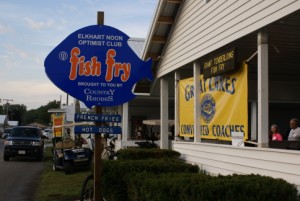
The Elkhart Noon Optimist pavilion where the GLCC social was held.
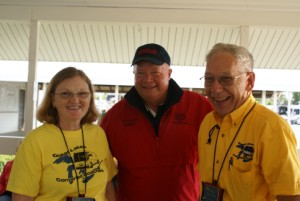
L-2-R: Vicky Lintner, Jon Walker (FMCA Senior National Vice-President), Larry Baker (GLCC President).
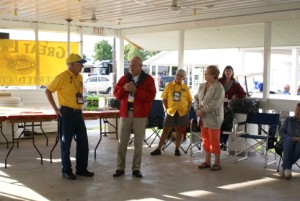
L-2-R: Larry Baker, Charlie Adcock (FMCA National President), Linda Fay (GLCC Treasurer, Gloria Adcock, Fonda Williams.
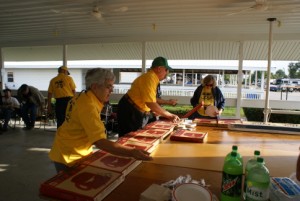
Getting the food and pop ready for dinner.
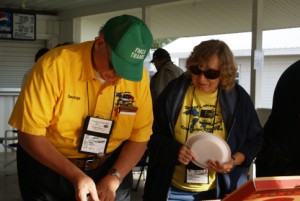
George and Sue Myers (GLAMARAMA shuttle service coordinators). Sue is the GLCC newsletter editor. George is the GLCC immediate past president and is the current president of the Friends of Angel Bus chapter.
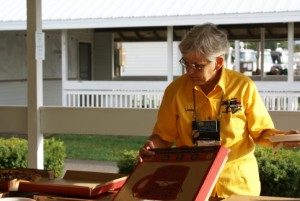
Linda Fay (GLCC Treasurer).
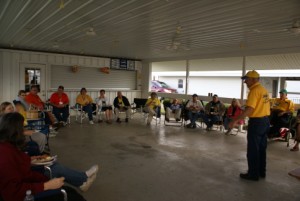
GLCC president Larry Baker conducting the chapter business meeting.
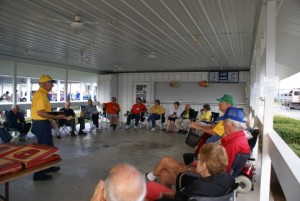
The GLCC business meeting in progress.
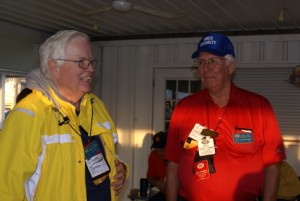
Pat Lintner (L, GLCC Secretary and National Director, and GLAMA Indiana VP) and Don Crawford (GLCC Founder/first president, and former GLAMA President and national area
VP.
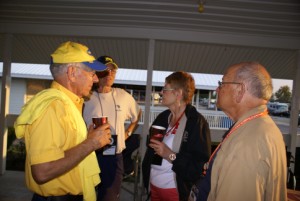
L-2-R: Larry Baker, Ron Walker, Judy Czarsty (FMCA past national president) and her husband.










